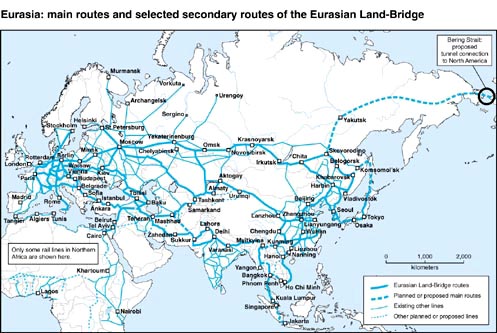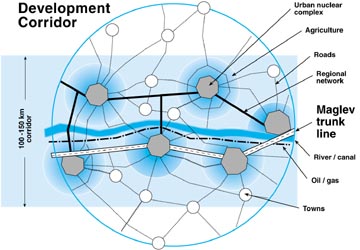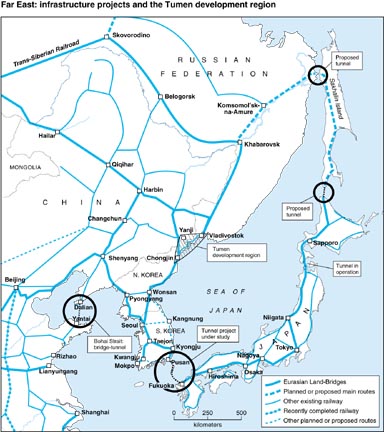
Highlights | Calendar | Music | Books | Concerts | Links | Education | Health
What's New | LaRouche | Spanish Pages | Poetry | Maps
Dialogue of Cultures
Koreas Open DMZ at Last:
Construction Begins on
The 'Iron Silk Road'
by Kathy Wolfe
September, 2002
 |
||
In the west, where the Seoul-Pyongyang Kyongui line is being rebuilt toward China, South Korean soldiers unlocked the ten-foot-high fence that runs the 250-kilometer length of the DMZ, at Dorasan Station in Paju, as thousands applauded. Simultaneously, 14.2 kilometers to the north, North Korea opened its fence at Kaesong Station. On the peninsula's east coast, where the Donghae-Wonsan line is being rebuilt toward Russia's Vladivostok, North Korean Prime Minister Hong Song-nam, Railway Minister Kim Yong-sam, and 3,000 guests cut the north fence of the DMZ at Onjong-ri at the foot of Mt. Kumgang (Diamond Mountain). Some 27 km to the south, South Korea opened its east coast fence in Kosung at the Unification Observatory, as crowds gazed north toward the revered Diamond Mountain.
At all four points, ceremonies with fireworks and music exploded. At the beautiful new Dorasan Station, a South Korean girl in white, symbolizing the North, emerged from behind the barbed wire holding a single red rose, and joined hands with a boy in a black suit, representing the South, also carrying a single rose. They joined a chorus singing the emotional "Our Wish Is Unification," as a train decked with a unification flag and flowers rolled slowly toward the fence where the rails end. Overhead screens broadcast simultaneous ceremonies in the east.
In more ceremonies on Sept. 19, 2002, construction began: South and North Korean soldiers simultaneously entered the DMZ at all four points for mine-clearing operations. Near Dorasan, 50 soldiers with live ammunition and 50 engineering troops followed a German-made mine-sweeper along the rail lines in a massed procession of trucks, backhoes, bulldozers, and an ambulance.
The military determination with which the Koreans seek to make their country whole was clear from the front-page photo of Seoul's top daily, the Korea Times, showing troops marching in formation behind the mine-sweeper. "This is not a simple construction job but a historic military operation," said Lt. Col. Bae Yoon-Hyo. "North Korean troops, whose weapons are normally trained on us, are instead doing their work at the same time."
If work goes smoothly, the western railway is to be reopened this year, making it possible to travel by train from Seoul to Pyongyang for the first time since the 1940s. A western road will be opened alongside next Spring. An east coast road could be opened as early as December, to allow family reunions at Diamond Mountain. The east coast railway is to be finished in early 2003.
Distances are short, but the engineering feat is huge. The DMZ is a 4 km-wide no-man's land strewn with millions of land mines, running 250 km from sea to sea. Troops must clear some 2,000 mines from each of their 2 km halves, on both coasts, to create a 250 meter corridor in the west and a 100 meter one in the east for rail and roadways.
'The Work of All Eurasia'
South Korean President Kim Dae-jung was in Europe Sept. 20-24, urging European leaders again to help rebuild not only the Trans-Korean Railway, but the entire length of the New Silk Road, from Pusan in the southern tip of Korea, to Paris, across Eurasia. Yonhap News reported that in Copenhagen on Sept. 22, "He will ask Asia-Europe Meeting (ASEM) nations for cooperation in South Korea's ambitious plan to realize an `Iron Silk Road' railway linking the Korean Peninsula to Europe."
Economist, statesman, and U.S. Presidential pre-candidate Lyndon LaRouche, the author of the 1992 "New Silk Road—Eurasian Land-Bridge" concept, was overjoyed with the events. As EIR reported on Sept. 13, the sudden breakthroughs in Korea are not a domestic affair, but an international strategic move by the heads of state of Russia, Japan, and China, as well as both Koreas, to stop the threatened Mideast war from spreading into Asia. Furthermore, "this was beyond only that" LaRouche added, referencing both Kim's European trip and private initiatives by certain Europeans. "This was the work of all Eurasia, including Germany, to help the Koreas solve the problem. This was their answer to the devil"—meaning, the threat of global war and economic collapse.
President Kim, who has adopted what he calls the "Iron Silk Road" from LaRouche's original idea, is vocal about his grand Eurasian-wide vision. "South Korea and Europe could be connected if we link only 14 kilometers of rail," Kim said recently, repeating his slogan of December 2001 at the European Parliament in Strasbourg, France. Korea, Kim said, could become the gateway to the Pacific for Europe, via this Eurasian Land-Bridge. "When the Trans-Korean Railway is linked with the Trans-China or the Trans-Siberian Railway, a train leaving London could reach Seoul and Pusan via Paris, Eastern Europe, Central Asia, and Siberia or China. Goods could be shipped to all Pacific regions from Pusan, the third-largest container port in the world. Transportation costs would be cut by 30% and time shortened by two-thirds," he said. (Click or scroll down for Eurasian Landbridge Maps and Infrastructure Corridor.)
The Presidents of Russia, the Philippines, and the European Union congratulated both Koreas on Sept. 18. Russian President Vladimir Putin said he is "sure this wise decision will expedite constructive progress in inter-Korean reconciliation and reunification."
'Japan's Grand Entrance'
The international nature of the New Silk Road strategy, as a Eurasian-wide proposal for rapid economic development, in opposition to global war, was also put in sharp focus by the remarkable surprise summit on Sept. 17 in Pyongyang, between Japanese Prime Minister Junichiro Koizumi and North Korean Chairman Kim Jong-il. The nominal antagonists reached a sweeping set of what Japan's Foreign Ministry called "comprehensive accords," agreeing to formal diplomatic normalization talks in October, said a joint statement by the two leaders.
"Underlying the summit is a plan which Russian President Putin, Kim Jong-il, and [South Korean President] Kim Dae-jung are playing out together, to woo cash from Japan," to help raise the $2.2 billion needed for reconnecting the Trans-Korean Railway, said Hideshi Takesada at Tokyo's National Institute for Defense Studies. Putin has held several summits with both Kim and Koizumi in recent years, emphasizing Russia's support for the New Silk Road. Japan could already be committing close to $10 billion for the project. The Kim-Koizumi joint statement said Tokyo will provide North Korea with grants-in-aid, low-interest loans, and aid through international organizations upon normalization of diplomatic ties. When Tokyo normalized relations with Seoul in 1965, it gave $500 million—about $10 billion in today's terms—in apology for Japan's 1895-1945 occupation of Korea.
"You could call it `Japan's grand entrance' into the Eurasian Land-Bridge," said one Korean observer. Despite much historic rancor between Tokyo and its neighbors, the reality is that Japan's technological, industrial, and financial might are central to the Eurasian grand project. There is already serious discussion of linking Japan's famous Bullet train lines directly to Europe, by building an ambitious bridge-tunnel system between Pusan, South Korea, and Fukuoka, Japan, as EIR reported on Sept. 13. Prime Minister Koizumi, a diplomat's nightmare who has long alienated many Asian nations, "is not running the show," said one source. This is a strategic policy decision by a large faction of Japan's elite.
Events inside North Korea are also key. Kim Jong-il demonstrated what Korean observers had forecast as a decisive turn in Pyongyang policy, away from "military hard-liners" who prefer confrontation.
The summit's big shock came when Chairman Kim gave a full apology for North Korean abductions of 11 Japanese during the 1970s-1980s. "The people responsible for this incident have been punished and we will never see this kind of thing happen again," a Japanese official quoted Kim saying. "I take this opportunity to express my regret and apologize sincerely. . . . This happened over decades of hostile relations and I want to talk about it frankly." Kim said four Japanese were still alive and could return home to Japan, and that those responsible in North Korea's military "have been sternly punished."
Kim also agreed to cease any further North Korean missile tests "beyond 2003," said the statement, and to accept nuclear inspections, largely pulling the rug out from under the Anglo-American utopians' war drive to label North Korea the next launching ground for world war after Iraq.
As part of the "comprehensive approach," Japan also made surprising concessions. In addition to the financial agreement, these included a full apology for Japan's occupation of Korea. "Japan humbly recognizes the historical fact that it caused tremendous damage and suffering to the people of Korea through its past colonial rule and expressed feelings of deep remorse and heartfelt apology," the statement said, repeating a 1995 apology by Japanese Prime Minister Tomiichi Murayama to China and Asian nations in general.
Koizumi also called for Kim's cooperation in support of Tokyo and Moscow's proposal for six-way talks among the two Koreas, the United States, China, Russia, and Japan. Kim replied that North Korea is prepared to join such a framework, a Japanese official said. Bringing Japan and Russia to the table is another factor meant to dilute the war cries from Washington. The joint statement says that Japan and North Korea have reached a comprehensive solution to nuclear issues on the Korean Peninsula and confirmed their cooperation in maintaining and strengthening peace and stability in Northeast Asia.
"We sense North Korea has changed, expressing more willingness to listen to our proposals and to talk," said Kenji Hiramatsu of Japan's Foreign Ministry.
End of Bush Unilateralism
The Pyongyang summit pulls several rugs out from under the war party in Washington. A Korea Times editorial on Sept. 17 (plainly leaked by the President's Blue House), is entitled "Is North Korea Ready for Peace? Koizumi Picks Up Where Kim Left Off." It compares the Koizumi-Kim summit to South Korean President Kim Dae-jung's first historic June 2000 Pyongyang trip, asserting that Koizumi's trip was architected by President Kim Dae-jung. "The Japanese Premier did what Kim bid him to do—settling Tokyo's biggest unsolved diplomatic task. He decided to make perhaps his biggest wager, going to Pyongyang to meet the man who holds the key to the deadlock.
Koizumi, the man once considered as disdainful of the country his ancestors ruled with an iron fist." The editorial quotes a Blue House official: " `I think that the Koizumi-Kim Jong-il summit will result in things whose repercussions will be felt for a long time to come in terms of a lasting peace on the peninsula, as well as in the region.' " And the paper concludes, "This will most likely affect Bush, who is busy waging his war on global terrorism, and make him reconsider his attempt to introduce unilateralism, the sword Bush uses to rearrange the world order as he sees fit. This seems to be the only approach available to the Kim Dae-jung Administration to have the United States change its mind and give another chance to inter-Korean rapprochement."
At the DMZ on Sept. 17, the two Koreas finalized a historic accord between their two militaries—under bitter negotiations for over two years—which will allow engineering troops to clear mines and build railways in cooperation. The accords, signed by both the North and South Korean Ministers of Defense, were exchanged at the border truce village of Panmunjom. "Today we have completed all paperwork needed to start work on the reconnection of cross-border railway and road links," a South Korean Unification Ministry official said at the exchange of documents signed by both South and North Korean Defense Ministers. The accord ensures the safety of soldiers who will walk into the DMZ to clear mines.
South and North Korean military officials hailed the military accord as a springboard for rapprochement. "This demonstrates our firm determination to implement the peace declaration" of the leaders of the two Koreas in June 2000, North Korea's chief delegate, Ryu Yong-chul, said. His South Korean counterpart, Brig. Gen. Kim Kyong-duck, said the military accord will open the door for reunification of the Korean peninsula.
Click for MAP of Korea Rail Projects PDF Version - same link as above)
Update on Eurasian Landbridge (More Maps )
Korean Lyric Song and Related Music Articles
Join and Support the Schiller Institute!
Eurasian Landbridge map
click for larger version



schiller@schillerinstitute.org
The Schiller Institute
PO BOX 20244
Washington, DC 20041-0244
703-297-8368
Thank you for supporting the Schiller Institute. Your membership and contributions enable us to publish FIDELIO Magazine, and to sponsor concerts, conferences, and other activities which represent critical interventions into the policy making and cultural life of the nation and the world.
Contributions and memberships are not tax-deductible.
VISIT THESE OTHER PAGES:
Home | Search | About | Fidelio | Economy | Strategy | Justice | Conferences | Join
Highlights | Calendar | Music | Books | Concerts | Links | Education | Health
What's New | LaRouche | Spanish Pages | Poetry | Maps
Dialogue of Cultures
© Copyright Schiller Institute, Inc. 2002. All Rights Reserved.